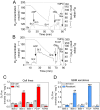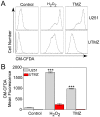Acquisition of chemoresistance in gliomas is associated with increased mitochondrial coupling and decreased ROS production
- PMID: 21931801
- PMCID: PMC3170372
- DOI: 10.1371/journal.pone.0024665
Acquisition of chemoresistance in gliomas is associated with increased mitochondrial coupling and decreased ROS production
Abstract
Temozolomide (TMZ) is an alkylating agent used for treating gliomas. Chemoresistance is a severe limitation to TMZ therapy; there is a critical need to understand the underlying mechanisms that determine tumor response to TMZ. We recently reported that chemoresistance to TMZ is related to a remodeling of the entire electron transport chain, with significant increases in the activity of complexes II/III and cytochrome c oxidase (CcO). Moreover, pharmacologic and genetic manipulation of CcO reverses chemoresistance. Therefore, to test the hypothesis that TMZ-resistance arises from tighter mitochondrial coupling and decreased production of reactive oxygen species (ROS), we have assessed mitochondrial function in TMZ-sensitive and -resistant glioma cells, and in TMZ-resistant glioblastoma multiform (GBM) xenograft lines (xenolines). Maximum ADP-stimulated (state 3) rates of mitochondrial oxygen consumption were greater in TMZ-resistant cells and xenolines, and basal respiration (state 2), proton leak (state 4), and mitochondrial ROS production were significantly lower in TMZ-resistant cells. Furthermore, TMZ-resistant cells consumed less glucose and produced less lactic acid. Chemoresistant cells were insensitive to the oxidative stress induced by TMZ and hydrogen peroxide challenges, but treatment with the oxidant L-buthionine-S,R-sulfoximine increased TMZ-dependent ROS generation and reversed chemoresistance. Importantly, treatment with the antioxidant N-acetyl-cysteine inhibited TMZ-dependent ROS generation in chemosensitive cells, preventing TMZ toxicity. Finally, we found that mitochondrial DNA-depleted cells (ρ°) were resistant to TMZ and had lower intracellular ROS levels after TMZ exposure compared with parental cells. Repopulation of ρ° cells with mitochondria restored ROS production and sensitivity to TMZ. Taken together, our results indicate that chemoresistance to TMZ is linked to tighter mitochondrial coupling and low ROS production, and suggest a novel mitochondrial ROS-dependent mechanism underlying TMZ-chemoresistance in glioma. Thus, perturbation of mitochondrial functions and changes in redox status might constitute a novel strategy for sensitizing glioma cells to therapeutic approaches.
Conflict of interest statement
Figures








Similar articles
-
Acquisition of temozolomide chemoresistance in gliomas leads to remodeling of mitochondrial electron transport chain.J Biol Chem. 2010 Dec 17;285(51):39759-67. doi: 10.1074/jbc.M110.147504. Epub 2010 Sep 24. J Biol Chem. 2010. PMID: 20870728 Free PMC article.
-
β-catenin contributes to cordycepin-induced MGMT inhibition and reduction of temozolomide resistance in glioma cells by increasing intracellular reactive oxygen species.Cancer Lett. 2018 Oct 28;435:66-79. doi: 10.1016/j.canlet.2018.07.040. Epub 2018 Aug 4. Cancer Lett. 2018. PMID: 30081068
-
The CHAC1-inhibited Notch3 pathway is involved in temozolomide-induced glioma cytotoxicity.Neuropharmacology. 2017 Apr;116:300-314. doi: 10.1016/j.neuropharm.2016.12.011. Epub 2016 Dec 13. Neuropharmacology. 2017. PMID: 27986595
-
TFR2 regulates ferroptosis and enhances temozolomide chemo-sensitization in gliomas.Exp Cell Res. 2023 Mar 1;424(1):113474. doi: 10.1016/j.yexcr.2023.113474. Epub 2023 Jan 23. Exp Cell Res. 2023. PMID: 36702193 Review.
-
The tumor-associated fibrotic reactions in microenvironment aggravate glioma chemoresistance.Front Oncol. 2024 May 28;14:1388700. doi: 10.3389/fonc.2024.1388700. eCollection 2024. Front Oncol. 2024. PMID: 38863628 Free PMC article. Review.
Cited by
-
Carmofur prevents cell cycle progression by reducing E2F8 transcription in temozolomide-resistant glioblastoma cells.Cell Death Discov. 2023 Dec 12;9(1):451. doi: 10.1038/s41420-023-01738-x. Cell Death Discov. 2023. PMID: 38086808 Free PMC article.
-
Synergistic combination of chemo‑phototherapy based on temozolomide/ICG‑loaded iron oxide nanoparticles for brain cancer treatment.Oncol Rep. 2019 Nov;42(5):1709-1724. doi: 10.3892/or.2019.7289. Epub 2019 Aug 21. Oncol Rep. 2019. PMID: 31436296 Free PMC article.
-
3D Quantitative and Ultrastructural Analysis of Mitochondria in a Model of Doxorubicin Sensitive and Resistant Human Colon Carcinoma Cells.Cancers (Basel). 2019 Aug 27;11(9):1254. doi: 10.3390/cancers11091254. Cancers (Basel). 2019. PMID: 31461915 Free PMC article.
-
The matricellular protein CCN6 differentially regulates mitochondrial metabolism in normal epithelium and in metaplastic breast carcinomas.J Cell Commun Signal. 2022 Sep;16(3):433-445. doi: 10.1007/s12079-021-00657-9. Epub 2021 Nov 22. J Cell Commun Signal. 2022. PMID: 34811632 Free PMC article.
-
CD147 confers temozolomide resistance of glioma cells via the regulation of β-TrCP/Nrf2 pathway.Int J Biol Sci. 2021 Jul 13;17(12):3013-3023. doi: 10.7150/ijbs.60894. eCollection 2021. Int J Biol Sci. 2021. PMID: 34421346 Free PMC article.
References
-
- Saybasili H, Yuksel M, Haklar G, Yalcin AS. Effect of mitochondrial electron transport chain inhibitors on superoxide radical generation in rat hippocampal and striatal slices. Antioxid Redox Signal. 2001;3:1099–1104. - PubMed
-
- Staniek K, Gille L, Kozlov AV, Nohl H. Mitochondrial superoxide radical formation is controlled by electron bifurcation to the high and low potential pathways. Free Radic Res. 2002;36:381–387. - PubMed
-
- Richter C, Gogvadze V, Laffranchi R, Schlapbach R, Schweizer M, et al. Oxidants in mitochondria: from physiology to diseases. Biochim Biophys Acta. 1995;1271:67–74. - PubMed
-
- Trachootham D, Zhou Y, Zhang H, Demizu Y, Chen Z, et al. Selective killing of oncogenically transformed cells through a ROS-mediated mechanism by beta-phenylethyl isothiocyanate. Cancer Cell. 2006;10:241–252. - PubMed
Publication types
MeSH terms
Substances
Grants and funding
LinkOut - more resources
Full Text Sources

